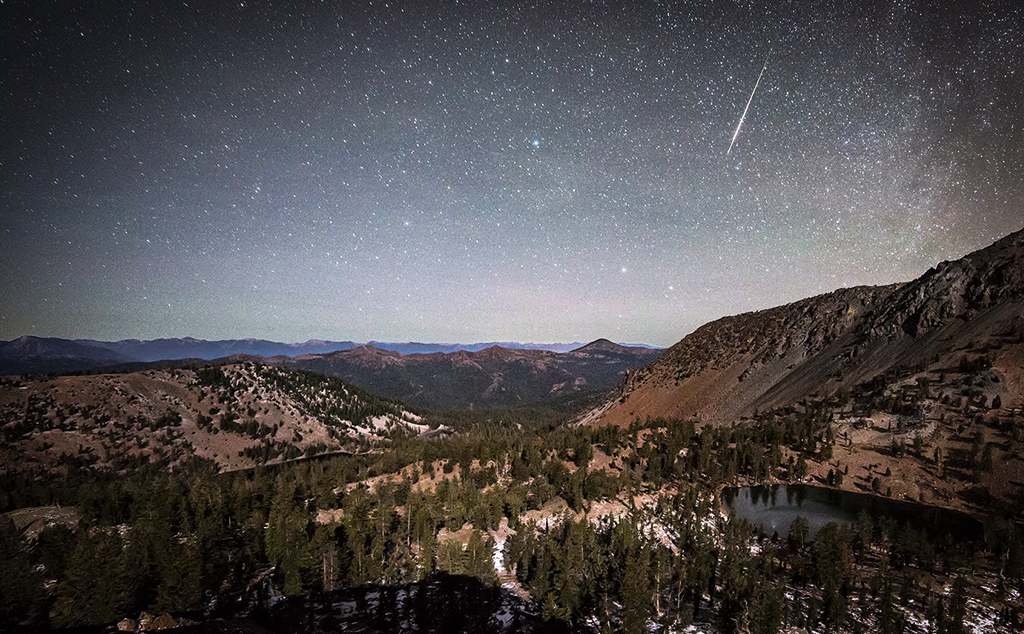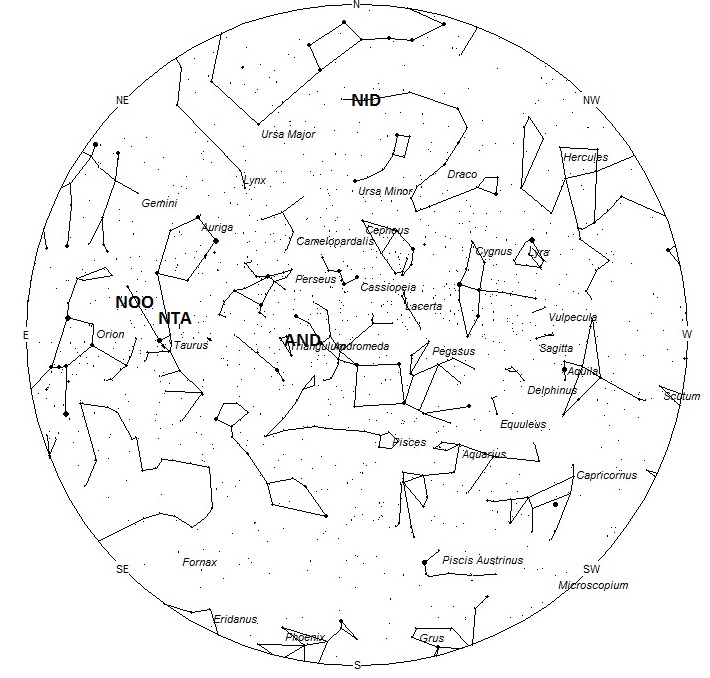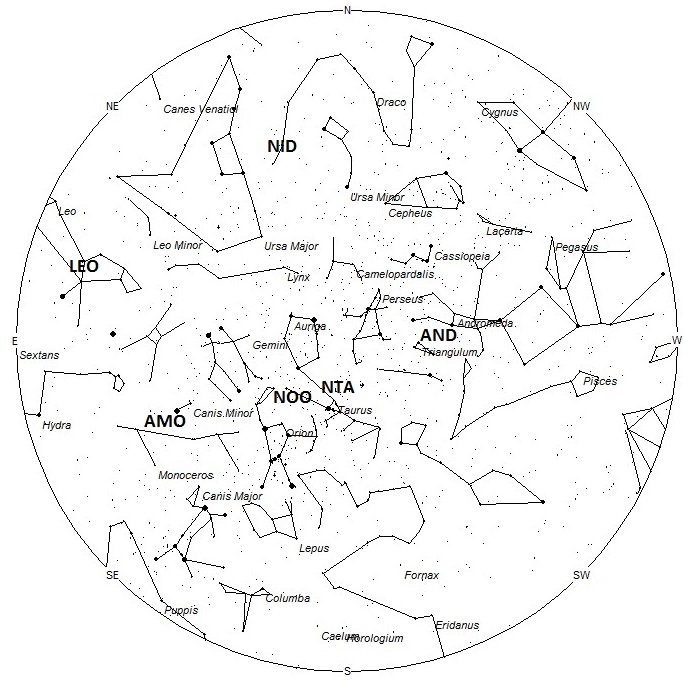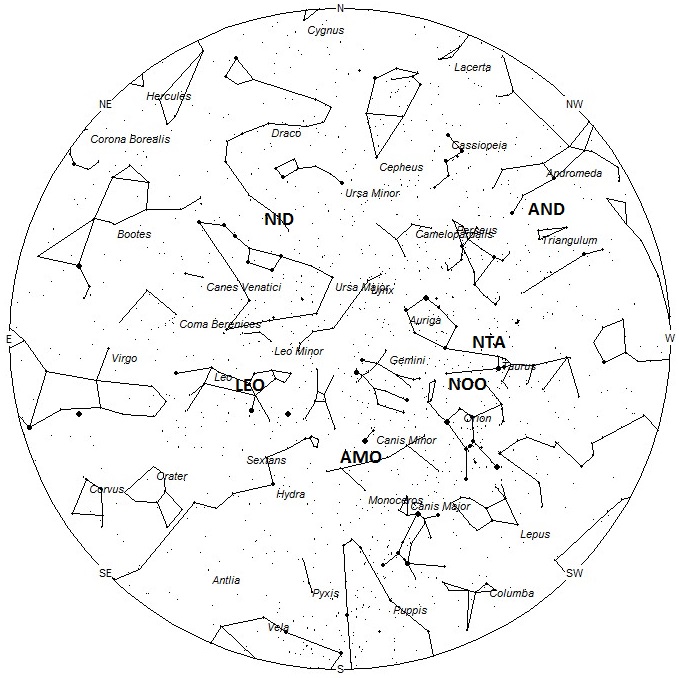
During this period the moon reaches its last quarter phase on Monday November 21st. At this time the moon will be located 90 degrees west of the sun and will rise between 2300 (11pm) and midnight local standard time. The moonlight will interfere with meteor observing during the prime morning hours but not nearly as much as when it was closer to its full phase. Viewing conditions improve with each passing night as the moon’s phase wanes and it rises later in the morning. The estimated total hourly meteor rates for evening observers this week is near 4 as seen from mid-northern latitudes (45N) and 3 as seen from tropical southern locations (25S). For morning observers the estimated total hourly rates should be near 18 as seen from mid-northern latitudes (45N) and 11 as seen from tropical southern locations (25S). Morning rates are reduced during this period due to moonlight. The actual rates will also depend on factors such as personal light and motion perception, local weather conditions, alertness and experience in watching meteor activity. Note that the hourly rates listed below are estimates as viewed from dark sky sites away from urban light sources. Observers viewing from urban areas will see less activity as only the brightest meteors will be visible from such locations.
The radiant (the area of the sky where meteors appear to shoot from) positions and rates listed below are exact for Saturday night/Sunday morning November 19/20 These positions do not change greatly day to day so the listed coordinates may be used during this entire period. Most star atlases (available at science stores and planetariums) will provide maps with grid lines of the celestial coordinates so that you may find out exactly where these positions are located in the sky. A planisphere or computer planetarium program is also useful in showing the sky at any time of night on any date of the year. Activity from each radiant is best seen when it is positioned highest in the sky, either due north or south along the meridian, depending on your latitude. It must be remembered that meteor activity is rarely seen at the radiant position. Rather they shoot outwards from the radiant so it is best to center your field of view so that the radiant lies at the edge and not the center. Viewing there will allow you to easily trace the path of each meteor back to the radiant (if it is a shower member) or in another direction if it is a sporadic. Meteor activity is not seen from radiants that are located below the horizon. The positions below are listed in a west to east manner in order of right ascension (celestial longitude). The positions listed first are located further west therefore are accessible earlier in the night while those listed further down the list rise later in the night.
These sources of meteoric activity are expected to be active this week.
The last of the Andromedids (AND) for this year are expected this weekend. The radiant will be located near 01:44 (026) +37 . This position lies in eastern Andromeda, 5 degrees east of the 2nd magnitude star known as Mirach (beta Andromedae). This part of the sky is best placed near 2100 (9pm) LST, when the radiant lies highest above the horizon. Current rates would most likely be less than 1 per hour no matter your location. With an entry velocity of 19 km/sec., the average Andromedid meteor would be of very slow velocity.
The Northern Taurids (NTA) are active from a large radiant located near 04:24 (066) +24. This position lies in central Taurus, 7 degrees northwest of the bright orange 1st magnitude star known as Aldebaran (alpha Tauri). Rates at this time should be near 3 per hour as seen from the northern hemisphere and 2 as seen south of the equator. These meteors may be seen all night long but the radiant is best placed near midnight LST when it lies on the meridian and is located highest in the sky. With an entry velocity of 27 km/sec., the average Northern Taurid meteor would be of slow velocity.
The November Orionids (NOO) are active from a radiant located at 05:24 (081) +17. This area of the sky is actually located in eastern Taurus, 4 degrees southwest of the 3rd magnitude star known as zeta Tauri. The peak for this radiant is not until November 28th, so current rates would be 1-2 shower members per hour, no matter your location. This location is close to the Northern Taurids , but far enough east to be distinguishable. The faster velocity of the November Orionids should help distinguish these meteors from the slower Taurids. The radiant is best placed for viewing near 0100 LST when it lies on the meridian and is highest above the horizon. With an entry velocity of 44 km/sec., the November Orionids would be of medium speed.
The Alpha Monocerotids (AMO) are a variable shower known for strong but short outbursts in 1985 and 1995. In most years just a few of meteors from this source are seen near November 22nd. Activity is usually limited to November 21-23 with a radiant located at 07:52 (118) +01. The area of the sky is located in southeastern Canis Minor just 5 degrees southeast of the brilliant 0 magnitude star known Procyon (Alpha Canis Minoris). The radiant was thought to originate in nearby Monoceros but recent refinements have placed it within the boundaries of Canis Minor. These meteors are best seen near 0300 LST, when the radiant lies highest above the horizon. With an entry velocity of 68 km/sec., most activity from this radiant would be of swift speed.
The Leonids (LEO) are the most active radiant in the sky, but rates are dwindling with each passing night. Expect rates this weekend to be near 5 per hour falling to near 3 per hour by the end of the week. The radiant is currently located at 10:20 (155) +21. This position lies in northwestern Leo, very close to the position occupied by the second magnitude double star Algeiba (Gamma Leonis). The Leonid radiant is best placed during the last hour before morning twilight when the radiant lies highest in a dark sky. Leonids may be seen from the southern hemisphere but the viewing conditions are not quite as favorable as those north of the equator. With an entry velocity of 70 km/sec., most activity from this radiant would be of swift speed with numerous persistent trains on the brighter meteors.
The November Iota Draconids (NID) were discovered by Dr. Peter Brown during his 7 year meteoroid stream survey using the Canadian Meteor Orbit Radar. This source is active from November 11 through the 1st of December with maximum activity occurring on November 26th. The radiant is currently located at 12:44 (191) +69. This area of the sky lies in western Draco, close to the position occupied by the 4th magnitude star known as Kappa Draconis. The radiant is best placed during the last hour before morning twilight when the radiant lies highest in a dark sky. Current hourly rates are expected to be less than 1 no matter your location. Due to the high northerly declination of the radiant these meteors are not visible from most of the southern hemisphere. Only southern equatorial regions would have any chance of seeing activity from this source. Meteors from the November Iota Draconids strike the atmosphere at 41km/sec., which would produce meteors of medium velocity.
As seen from the mid-northern hemisphere (45N) one would expect to see approximately 8 sporadic meteors per hour during the last hour before dawn as seen from rural observing sites. Evening rates would be near 3 per hour. As seen from the tropical southern latitudes (25S), morning rates would be near 5 per hour as seen from rural observing sites and 2 per hour during the evening hours. Locations between these two extremes would see activity between the listed figures. Morning rates are reduced due to lunar interference.
The table below presents a list of radiants that are expected to be active this week. Rates and positions are exact for Saturday night/Sunday morning except where noted in the shower descriptions.
| SHOWER | DATE OF MAXIMUM ACTIVITY | CELESTIAL POSITION | ENTRY VELOCITY | CULMINATION | HOURLY RATE | CLASS |
| RA (RA in Deg.) DEC | Km/Sec | Local Standard Time | North-South | |||
| Andromedids (AND) | Nov 08 | 01:44 (026) +37 | 19 | 21:00 | <1 – <1 | III |
| Northern Taurids (NTA) | Nov 11 | 04:24 (066) +24 | 27 | 00:00 | 3 – 2 | II |
| November Orionids (NOO) | Nov 29 | 05:24 (081) +17 | 44 | 01:00 | 2 – 1 | II |
| alpha Monocerotids (AMO) | Nov 21 | 07:18 (109) +01 | 65 | 03:00 | <1 – <1 | III |
| Leonids (LEO) | Nov 17 | 10:20 (155) +21 | 70 | 06:00 | 5 – 3 | III |
| November iota Draconids (NID) | Nov 26 | 12:44 (191) +69 | 41 | 08:00 | <1 – <1 | IV |
 American Meteor Society
American Meteor Society



520 pm eastern sky southbound meteorite seen form zip code 60084, anyone else see this?
On Sat. Nov. 19, I was just getting into my deer stand in Central Eastern OK at about 6:45 AM. when I saw a huge fireball move from the Western toward the Southern sky for approx. 8 seconds. It moved much slower due to its size and was very large. So big that I was not really sure if it was a meteor, comet etc…. Glad someone else saw it!
Dale Collins
I was also hunting on that same day and while climbing into my deer stand in New York saw that same meteor. Approximately 6:00 eastern time.
Nov 23, 2016 – This evening after sundown about 7:05 central time… In the West x southwest sky, meteor leaves thin granular tail of red hue, then the illumination intensifies in size from a red hue to street lamp yellow color and globular shape. Instead of feathered edges of a vapor trail, the size and intensity were steady for most of the appearance. It was different than any fireball I’ve seen. any one else see this ?
i was hunting in SE Oklahoma around 530AM CTRL Time and saw a massive fireball as well. It moved very slowly… awesome!